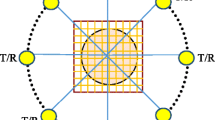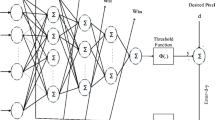Abstract
A 2D Compact ultrasound computerized tomography (UCT) system is developed. Fully automatic post-processing tools involving signal and image processing are developed as well. Square of the amplitude values are used in transmission mode with natural 1.5 MHz frequency and rise time 10.4 ns and fall time 8.4 ns and duty cycle of 4.32%. The highest peak to corresponding trough values are considered as transmitting wave between transducers in direct line talk. Sensitivity analysis of methods to extract peak to the corresponding trough per transducer are discussed in this paper. Total five methods are tested. These methods are taken from broad categories: (a) Conventional and (b) Artificial Intelligence (AI) based methods. Conventional methods, namely: (a) simple gradient based peak detection, (b) Fourier based, (c) wavelet transform, are compared with AI based methods: (a) support vector machine (SVM), (b) artificial neural network (ANN). The classification step is performed as well to discard the signal which does not has a contribution to the transmission wave. It is found that AI methods have equally good as compared to conventional methods. Reconstruction error, KT 1error estimates, accuracy, F-Score, recall, precision, specificity and MCC are used. ANN and FFT methods are processing the UCT signal with the best recovery.






Similar content being viewed by others
References
Abd Rahman, N. A., En Hong, L., Rahim, R., Rahim, H., Ahmad, N., Bunyamin, S., & Mansor, M. S. (2015). A Review: Tomography Systems in Medical and Industrial Processes. Jurnal Teknologi, 73, 1–11. https://doi.org/10.11113/jt.v73.4398
Honarvar, F., & Varvani-Farahani, A. (2020). A review of ultrasonic testing applications in additive manufacturing: Defect evaluation, material characterization, and process control. Ultrasonics, 108, 106227. https://doi.org/10.1016/j.ultras.2020.106227
Ibrahim, S., Yunus, M. A. M., Khairi, M. T. M., & Faramarzi, M. (2014). A review on ultrasonic process tomography system. Jurnal Teknologi, 70(3). https://doi.org/10.11113/jt.v70.3452
WHO Study Group on Training in Diagnostic Ultrasound : Essentials Pennsylvania P. and S. (1996) : P., & Organization W. H. (1998). Training in diagnostic ultrasound : essentials, principles and standards : report of a WHO study group. Geneva PP - Geneva: World Health Organization. Retrieved from https://apps.who.int/iris/handle/10665/42093
Goswami, M., Munshi, P., Khanna, A., & Saxena, A. (2015). Nonuniform Arrangement of Emitter-Receiver Pairs Arrangement and Compact Ultrasonic Tomography Setup. IEEE Sensors Journal, 15(2), 1198–1207. https://doi.org/10.1109/JSEN.2014.2361201
Krautkrämer, J., & Krautkrämer, H. (2013). Ultrasonic testing of materials. Springer Science & Business Media.
Chan, V., & Perlas, A. (2011). Basics of ultrasound imaging. In Atlas of ultrasound-guided procedures in interventional pain management (pp. 13–19). Springer.
Fuentes, R., Mineo, C., Pierce, S. G., Worden, K., & Cross, E. J. (2019). A probabilistic compressive sensing framework with applications to ultrasound signal processing. Mechanical Systems and Signal Processing, 117, 383–402. https://doi.org/10.1016/j.ymssp.2018.07.036
Parrilla, M., Anaya, J. J., & Fritsch, C. (1991). Digital signal processing techniques for high accuracy ultrasonic range measurements. IEEE Transactions on instrumentation and measurement, 40(4), 759–763. https://doi.org/10.1109/19.85348
Kogan, S. (2008). Electronic noise and fluctuations in solids. Cambridge University Press.
Neal, S. P., & Thompson, D. O. (1990). The Measurement and Analysis of Acoustic Noise as a Random Variable BT - Review of Progress in Quantitative Nondestructive Evaluation. In D. O. Thompson & D. E. Chimenti (Eds.), (pp. 625–632). Boston, MA: Springer US. https://doi.org/10.1007/978-1-4684-5772-8_78
Zhang, G.-M., & Harvey, D. M. (2012). Contemporary ultrasonic signal processing approaches for nondestructive evaluation of multilayered structures. Nondestructive testing and evaluation, 27(1), 1–27.
Hooge, F. N. (1994). 1/f noise sources. IEEE Transactions on Electron Devices, 41(11), 1926–1935. https://doi.org/10.1109/16.333808
Zidelmal, Z., Amirou, A., Ould-Abdeslam, D., Moukadem, A., & Dieterlen, A. (2014). QRS detection using S-Transform and Shannon energy. Computer methods and programs in biomedicine, 116(1), 1–9. https://doi.org/10.1016/j.cmpb.2014.04.008
Yang, G., Dai, J., Liu, X., Chen, M., & Wu, X. (2020). Spectral feature extraction based on continuous wavelet transform and image segmentation for peak detection. Analytical Methods, 12(2), 169–178.
Jarman, K. H., Daly, D. S., Anderson, K. K., & Wahl, K. L. (2003). A new approach to automated peak detection. Chemometrics and intelligent laboratory systems, 69(1–2), 61–76. https://doi.org/10.1016/S0169-7439(03)00113-8
Manikandan, M. S., & Soman, K. P. (2012). A novel method for detecting R-peaks in electrocardiogram (ECG) signal. Biomedical Signal Processing and Control, 7(2), 118–128. https://doi.org/10.1016/j.bspc.2011.03.004
Lange, E., Gröpl, C., Reinert, K., Kohlbacher, O., & Hildebrandt, A. (2006). High-accuracy peak picking of proteomics data using wavelet techniques. In Biocomputing 2006 (pp. 243–254). World Scientific. https://doi.org/10.1142/9789812701626_0023
Li, C., Huang, L., Duric, N., Zhang, H., & Rowe, C. (2009). An improved automatic time-of-flight picker for medical ultrasound tomography. Ultrasonics, 49(1), 61–72. https://doi.org/10.1016/j.ultras.2008.05.005
Herter, S., Youssef, S., Becker, M. M., & Fischer, S. C. L. (2021). Machine Learning Based Preprocessing to Ensure Validity of Cross-Correlated Ultrasound Signals for Time-of-Flight Measurements. Journal of Nondestructive Evaluation, 40(1), 20. https://doi.org/10.1007/s10921-020-00745-7
Andria, G., Attivissimo, F., & Giaquinto, N. (2001). Digital signal processing techniques for accurate ultrasonic sensor measurement. Measurement, 30(2), 105–114. https://doi.org/10.1016/S0263-2241(00)00059-2
Iyer, S., Sinha, S. K., Tittmann, B. R., & Pedrick, M. K. (2012). Ultrasonic signal processing methods for detection of defects in concrete pipes. Automation in Construction, 22, 135–148. https://doi.org/10.1016/j.autcon.2011.06.012
Yu, D., & Deng, L. (2011). Deep Learning and Its Applications to Signal and Information Processing [Exploratory DSP]. IEEE Signal Processing Magazine, 28(1), 145–154. https://doi.org/10.1109/MSP.2010.939038
Vijaya, G., Kumar, V., & Verma, H. K. (1998). ANN-based QRS-complex analysis of ECG. Journal of Medical Engineering & Technology, 22(4), 160–167. https://doi.org/10.3109/03091909809032534
Arbitrary Waveform Generators | Keysight. (n.d.). Retrieved July 17, 2021, from https://www.keysight.com/in/en/products/arbitrary-waveform-generators.html
Arbitrary Waveform Generators | Tektronix. (n.d.). Retrieved July 17, 2021, from https://www.tek.com/arbitrary-waveform-generator
Bhardwaj, A., Patel, K., Bhardwaj, M. C., & Fetfatsidis, K. A. (2014). Application of advanced non-contact ultrasound for composite material qualification. In ASNT Annual Conference 2014 (pp. 17–25).
Khan, A. A. (2005). Digital signal processing fundamentals. Firewall Media.
Sahidullah, M., & Saha, G. (2013). A Novel Windowing Technique for Efficient Computation of MFCC for Speaker Recognition. IEEE Signal Processing Letters, 20(2), 149–152. https://doi.org/10.1109/LSP.2012.2235067
Kadah, Y. M., Farag, A. A., Zurada, J. M., Badawi, A. M., & Youssef, A. B. (1996). Classification algorithms for quantitative tissue characterization of diffuse liver disease from ultrasound images. IEEE transactions on Medical Imaging, 15(4), 466–478. https://doi.org/10.1109/42.511750
Wang, C. C., & Chang, C. D. (2010). SVD and SVM based approach for congestive heart failure detection from ECG signal. In The 40th International Conference on Computers & Indutrial Engineering (pp. 1–5). IEEE. https://doi.org/10.1109/ICCIE.2010.5668319
Cao, C., & Wang, Z. (2018). IMCStacking: Cost-sensitive stacking learning with feature inverse mapping for imbalanced problems. Knowledge-Based Systems, 150, 27–37. https://doi.org/10.1016/j.knosys.2018.02.031
Zhu, Q. (2020). On the performance of Matthews correlation coefficient (MCC) for imbalanced dataset. Pattern Recognition Letters, 136, 71–80. https://doi.org/10.1016/j.patrec.2020.03.030
Shakya, S., & Munshi, P. (2015). Error analysis of tomographic reconstructions in the absence of projection data. Philosophical Transactions of the Royal Society A: Mathematical, Physical and Engineering Sciences, 373(2043), 20140394.
Chicco, D., & Jurman, G. (2020). The advantages of the Matthews correlation coefficient (MCC) over F1 score and accuracy in binary classification evaluation. BMC Genomics, 21(1), 6. https://doi.org/10.1186/s12864-019-6413-7
Khare, P., & Goswami, M. (2021). AI Algorithm for Mode Classification of PCF SPR Sensor Design. arXiv preprint arXiv:2107.06184.
Chowdhury, M., & Sadek, A. W. (2012). Advantages and limitations of artificial intelligence. Artificial intelligence applications to critical transportation issues, 6(3), 360–375.
Acknowledgements
MG acknowledge the Science and Engineering Research Board (SERB), Government of India, for providing support with Grant No. ECR/2017/001432. AK like to acknowledge CSIR Research fellowship. We also acknowledge Mr. Utakarsh Vinayak Parkhi’s help in testing preliminary KCNN codes in MATLAB™. AK acknowledges Dr. Snehlata Shakya for her help in KT1 theorem discussions.
Author information
Authors and Affiliations
Contributions
Ankur Kumar: Methodology, Investigation, data measurement, Writing and Analysis, non-AI methods. Prasunika Khare: AI methods and analysis, Mayank Goswami: Methodology, Investigation, Writing, Visualization, Supervision, Funding acquisition.
Corresponding author
Additional information
Publisher's Note
Springer Nature remains neutral with regard to jurisdictional claims in published maps and institutional affiliations.
Rights and permissions
About this article
Cite this article
Kumar, A., Khare, P. & Goswami, M. AI and Conventional Methods for UCT Projection Data Estimation. J Sign Process Syst 94, 425–433 (2022). https://doi.org/10.1007/s11265-021-01697-5
Received:
Revised:
Accepted:
Published:
Issue Date:
DOI: https://doi.org/10.1007/s11265-021-01697-5




